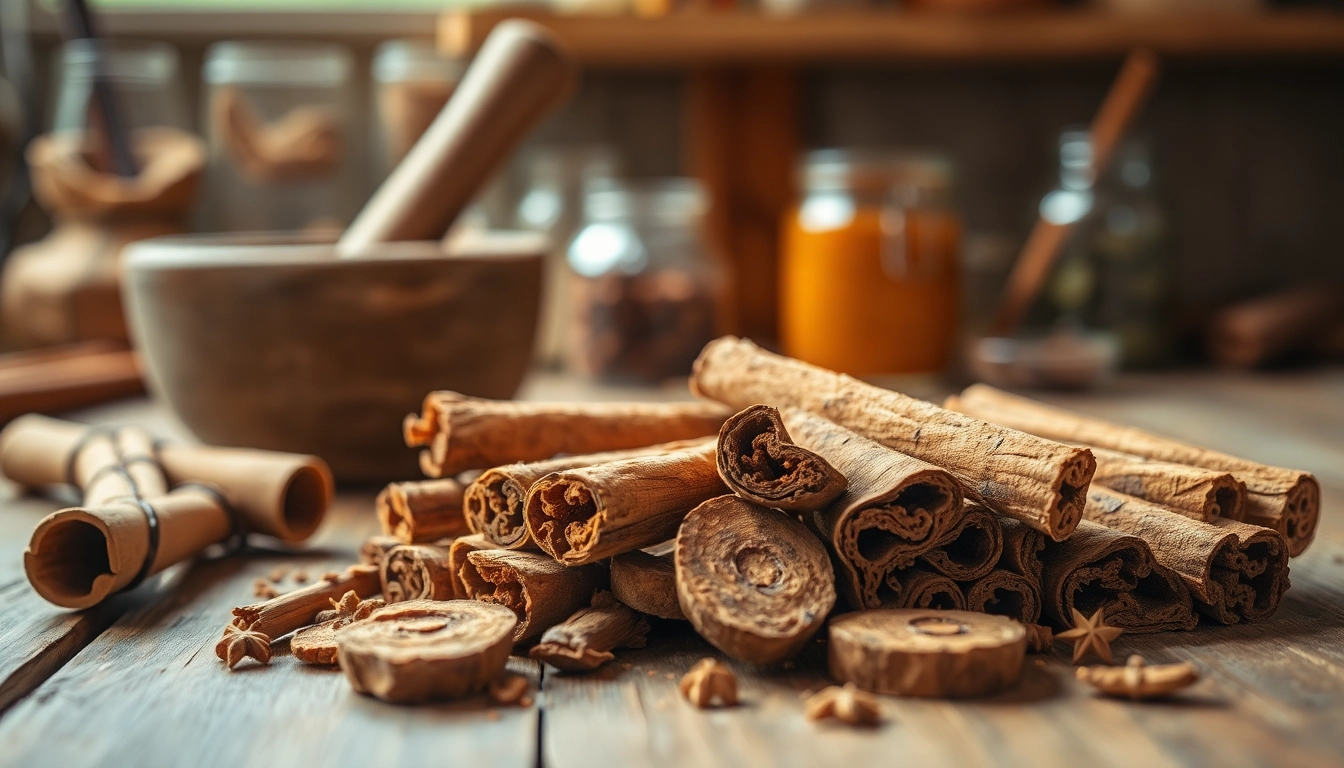What is Cinnamon Bark?
Cinnamon bark is derived from the inner bark of trees belonging to the Cinnamomum genus. It has been cherished for centuries not only for its sweet, warm flavor and aroma but also for its myriad of health benefits. Today, cinnamon bark is a staple in kitchens worldwide and serves as a powerful natural remedy. One popular variety embraced by culinary enthusiasts and health aficionados alike is Cinnamon Bark, celebrated for its rich flavor and therapeutic properties.
Types of Cinnamon Bark
There are several types of cinnamon bark, with the two most prominent varieties being Ceylon cinnamon (Cinnamomum verum) and Cassia cinnamon (Cinnamomum cassia). Ceylon cinnamon, often referred to as “true cinnamon,” is native to Sri Lanka and is known for its delicate, sweet flavor and lower levels of coumarin, a compound that can be harmful in excessive amounts. Cassia, on the other hand, is more widely available and has a stronger, spicier flavor. While both types offer distinct culinary qualities, their medicinal benefits and safety profiles vary significantly.
Botanical Origins and Characteristics
The cinnamon tree is an evergreen belonging to the laurel family. It thrives in tropical climates and can grow up to 15 meters tall. The harvesting process involves carefully stripping the inner bark from young branches, which is then dried and curled into the familiar cinnamon sticks or ground into fine powder. The essential oils released during this process contribute to its complex aroma and flavor. With over 250 identified species, the Cinnamomum genus showcases a rich biodiversity, each species exhibiting unique characteristics.
Culinary vs Medicinal Uses
Cinnamon bark is remarkably versatile, bridging the gap between food and wellness. In culinary applications, it is prized for its ability to enhance the flavor of both sweet and savory dishes. Cinnamon is commonly used in baking, chai blends, curries, and even gourmet chocolates. Medicinally, cinnamon bark is valued for its historical use in traditional medicine. It has been recommended for various ailments including digestive issues, inflammation, and blood sugar management. The combination of culinary delight and medicinal efficacy makes cinnamon bark a cherished ingredient in both kitchens and apothecaries.
Health Benefits of Cinnamon Bark
The health benefits of cinnamon bark have garnered significant attention in recent years, supported by various studies that highlight its potential therapeutic properties.
Antioxidant Properties
Cinnamon bark is packed with antioxidants, which are crucial for combatting oxidative stress in the body. Antioxidants help neutralize free radicals, thereby reducing the risk of chronic diseases such as heart disease and cancer. Research indicates that compounds such as polyphenols in cinnamon bark may be even more potent than those found in other well-known sources like garlic or oregano. This makes cinnamon an excellent addition to a balanced diet aimed at promoting health and longevity.
Effects on Blood Sugar and Metabolism
Numerous studies suggest that cinnamon bark plays a role in managing blood sugar levels. It has been shown to improve insulin sensitivity and lower fasting blood sugar levels, particularly beneficial for individuals with type 2 diabetes. Cinnamon may mimic insulin’s effects and increase glucose metabolism in the body. This leads to better energy regulation and overall metabolic health.
Potential Anti-inflammatory Benefits
Cinnamon bark contains anti-inflammatory properties that can help reduce inflammation in the body. Chronic inflammation is linked to various diseases, including autoimmune conditions and metabolic disorders. Ingredients found in cinnamon are believed to inhibit the production of inflammatory mediators and may provide relief from symptoms associated with chronic inflammatory conditions.
How to Incorporate Cinnamon Bark into Your Diet
Incorporating cinnamon bark into your daily routine can be simple and enjoyable. Below are a few methods to unleash its flavor and health benefits.
Culinary Applications
Cinnamon bark is incredibly versatile in the kitchen. It can be used in both sweet and savory dishes. Add sticks to your pot of chili or slow-cooked stews to enhance depth of flavor. For sweet applications, consider incorporating crushed cinnamon bark into oatmeal, smoothies, or desserts like apple pie. It works particularly well in baked goods, lending warmth and richness to muffins, cookies, and bread.
Teas and Herbal Remedies
Cinnamon bark is a popular ingredient in herbal teas, with blends that range from chai to simple cinnamon-infused water. To prepare a soothing tea, simmer a few sticks of cinnamon bark in water for 10-15 minutes, then add honey or lemon to taste. This not only provides a delightful beverage but also harnesses the health benefits packed in cinnamon.
Baking and Desserts
Baking is another fantastic avenue for enjoying cinnamon bark. It can be grated, powdered, or left whole, depending on the recipe. Use ground cinnamon bark to enhance the flavor of chocolate desserts or sprinkle it atop vanilla ice cream for a gourmet touch. Its aromatic qualities make it an ideal candidate for infusing flavors into cakes, pies, and pastries.
Comparing Cinnamon Varieties: Ceylon vs. Cassia
Understanding the differences between cinnamon varieties can significantly impact culinary choices and health benefits. Two popular types of cinnamon, Ceylon and Cassia, differ in flavor, nutritional content, and safety.
Flavor Profiles and Culinary Uses
Ceylon cinnamon has a sweet, delicate flavor, making it preferred in dishes where a subtle cinnamon taste is desired. In contrast, Cassia cinnamon has a stronger, more pungent flavor that can dominate a dish, which makes it commonly used in spiced beverages and hearty desserts. The choice between the two largely depends on personal preference and the intended use in cooking.
Nutritional Differences
Nutritionally, Ceylon cinnamon boasts lower levels of coumarin, a compound that can be toxic in high quantities. Cassia cinnamon contains higher levels, which prompts some health-conscious consumers to prefer Ceylon cinnamon for daily use. Furthermore, Ceylon cinnamon is often richer in antioxidants compared to Cassia, making it a healthier choice for regular incorporation into the diet.
Choosing the Right Type for Your Needs
When considering which type of cinnamon to purchase, think about your intended use and frequency of consumption. If you’re an avid user, opting for high-quality Ceylon cinnamon is advisable to minimize potential health risks associated with coumarin. For occasional baking, Cassia may suffice for its bolder flavor. Always look for reputable sources to ensure you’re receiving the highest quality cinnamon bark.
Purchasing and Storing Cinnamon Bark
Finding high-quality cinnamon bark can enhance your culinary delights and health advantages significantly.
Where to Buy High-Quality Cinnamon Bark
High-quality cinnamon bark can often be found at health food stores, specialty spice shops, and online marketplaces. When purchasing cinnamon, look for products that specify the type of cinnamon, ensuring that it meets your culinary and health requirements. Organic and fair-trade products are preferable for ethical sourcing.
Storage Tips for Freshness and Flavor
To maintain the freshness and flavor of your cinnamon bark, store it in an airtight container away from light, heat, and humidity. Whole cinnamon sticks can last up to four years in optimal conditions, while ground cinnamon is best used within six months for peak flavor.
Understanding Labels and Certifications
When selecting cinnamon products, familiarizing yourself with labels and certifications can help ensure that you are buying high-quality, safe products. Look for indications of organic certification, fair-trade practices, and specific species names. Accurate labeling ensures that you know exactly what you’re using in your cooking and for your health.


